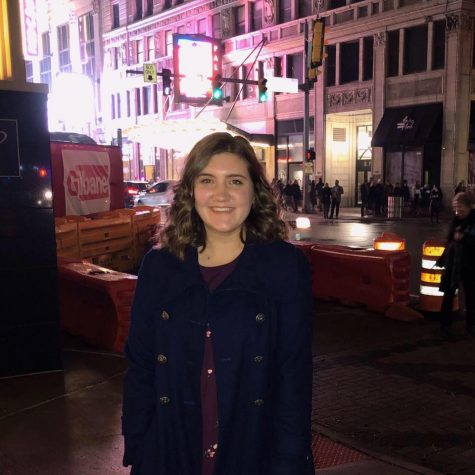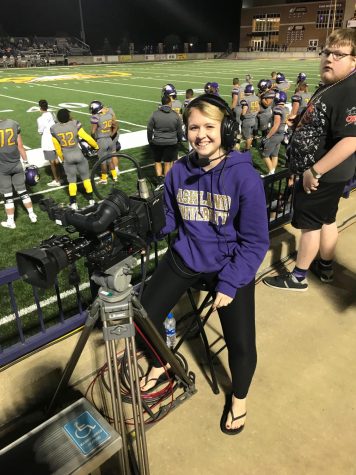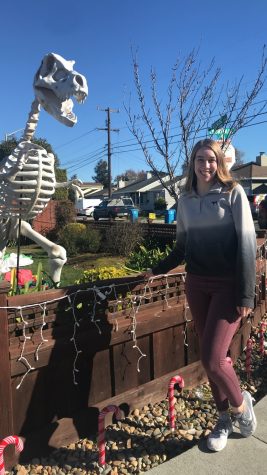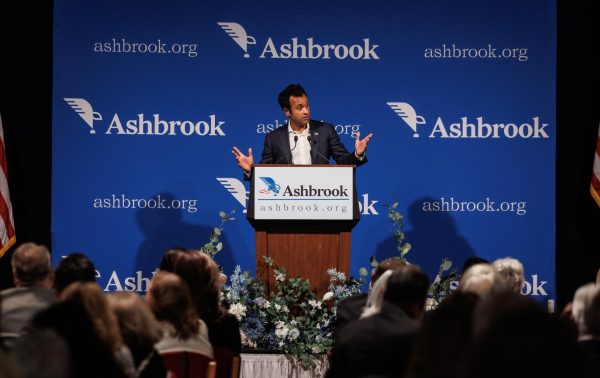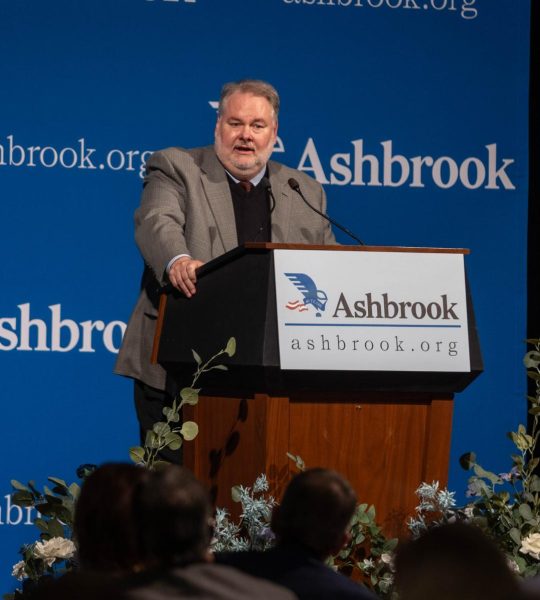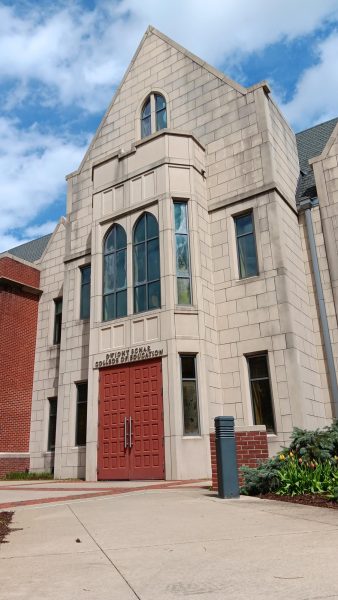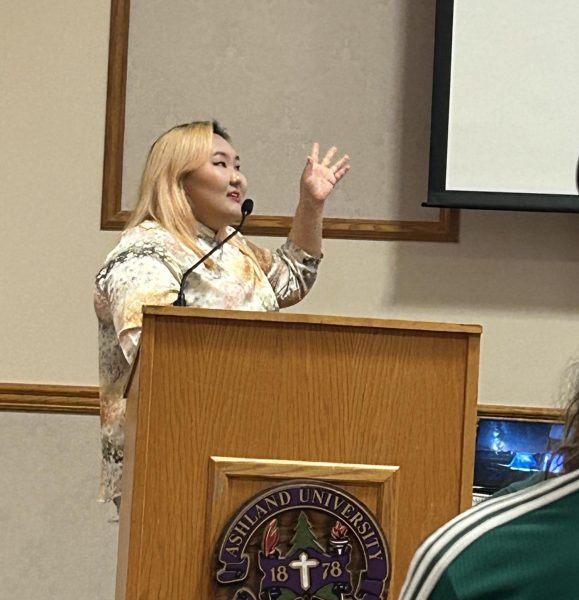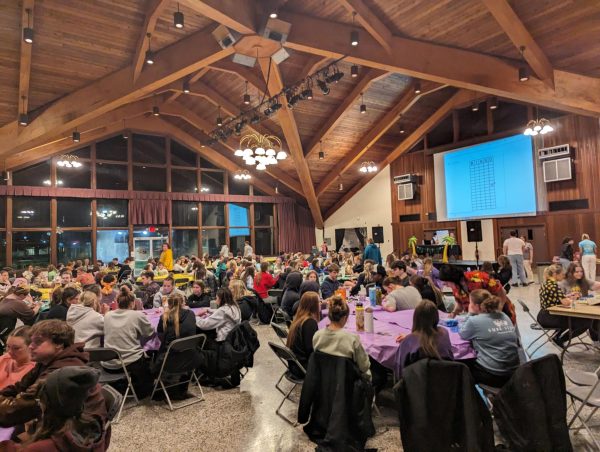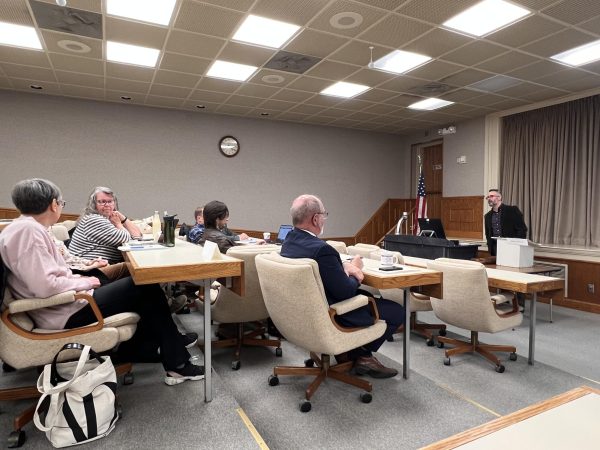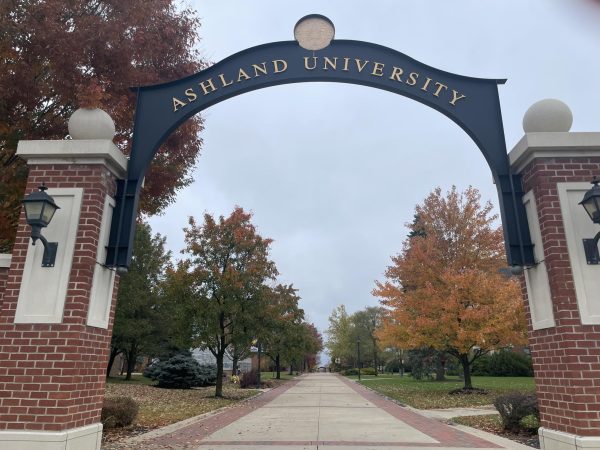Teaching behind a mask
An inside look at high school and college classrooms
Dr. David Aune wearing a mask while teaching “Understanding Islam” in Dauch 105
September 18, 2020
Beyond the masks, six-foot distance and foggy glasses, the world of higher education has been witness to many changes in a short period of time.
New mandates have plagued campuses as new school years begin, with administration on standby awaiting a signal that may shut universities down once again. These changes in the classroom come as no surprise to many Ashland University professors.
Co-Chair of the Department of Teacher Education at AU Dr. Robert Cyders, has witnessed many new learning tools being introduced to schools. He worked at the Ohio Department of Education for eight years as a member of the School Improvement Diagnostic Review team.
Students that graduated in the Spring and wanted to move on to teach had to wait to take the teaching exams and were given a new license – a single year license. This allows recent graduates to teach, but they are required to take the exams as soon as the license expires.
Teaching in the Schar Building of Education has been modified to teach students how to adapt to new challenges in the school systems. Professors also had to adjust to teaching in a new format.
“There are some things that you can’t achieve in online instruction,” Cyders said. “I never realized how much I tried to read the body language of my students, until I found myself trying to figure out ‘did they get this concept that I’ve been teaching, or do I need to keep on going?’”
The lack of face-to-face communication also has brought upon new challenges for educators.
“Personally, I need that interaction with my students… I rely on facial expressions. Now, I have to be more overt with my students to make sure they understand the concept,” he said.
Cyders said, schools have a unique opportunity right now.
Education majors are now being encouraged by school districts to learn how to teach from an online format.
Educators are now able to reshape how the learning format looks because they had the ability to test both online and in-person classes. Teachers are able to take the good parts of the two, and re-work those aspects into a new and improved format.
“The change has been good in that it has forced us to discover things about ourselves that we didn’t think we knew,” Cyders said.
Paul Hyman, chair of the biology and toxicology department, believes that the majors and minors within Kettering adapted well to a newer form of learning — online.
“Last semester I was teaching microbiology, which is a major lab course. There was no way,” he said. “For the most part [last semester] I just abandoned the lab.”
Luckily, the course was frontloaded, and most of the hands-on labs were done in the beginning before COVID concerns struck the classrooms.
During spring break, the professors and students were informed they would not be going back to campus. Hyman said that the test scores were not as poor as he expected.
Most science-based classes were able to switch to hybrid classes with little issue.
Reuse of equipment is more of a contamination issue for classes like biology and chemistry, but professors of science have found ways to work around that and still maintain safe distancing.
One answer has been to split classes in half. This method means one portion of the class will meet in-person one day and the other will work online, and vice-versa.
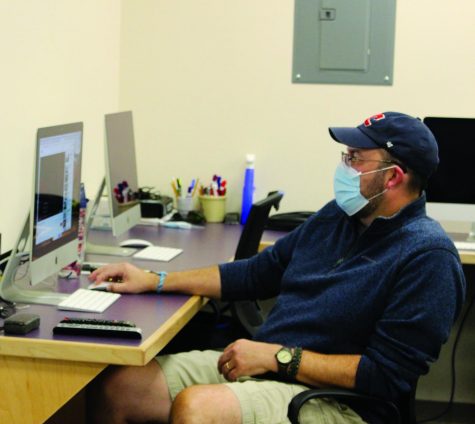
Alternating face-to-face classes is showing to be a successful method of teaching for lab professors since no classroom can fit all the students while respecting social distancing.
“In one class we have several students who are virtual which I am co-teaching with another professor,” Hyman said. “For my class, I’ve taken out one of the standard days in one class and replaced it with a narrated powerpoint. In some ways there are advantages to Zoom, scheduling is easier now because there’s two different ways to do it – in-person and online.”
These changes in class structure is happening in other areas on campus as well.
“I think what people are going to find is that they now have new tools and ways of doing things, some of them may incorporate them into teaching and others just won’t like them at all.”
But what does class look like outside of AU?
Back in March, high schools would have been filled with teenagers anxiously awaiting spring break crowding around textbooks and computer screens hurrying to finish final assignments before a week of freedom.
Students leaned against teachers’ desks, whispered secrets into each other’s ears and shared drinks at lunch with friends. Then, the unthinkable happened.
It came to a sudden halt.
A haunting feeling took over the empty desks and abandoned rooms while panic set in among the teachers.
According to Kelly Swearingen, English 9 and journalism teacher at Ashland High School, the teachers were left with a 16-hour notice to switch their entire in-person curriculum to an online format.
“I can’t imagine being in that position as a first year teacher,” she said. “That would have been the most stressful experience.”
With little to no training, these teachers adjusted to the virtual world in order to finish out the 2019-2020 school year.
However, there was more time for preparation this year. Teachers were given three weeks of professional development to help prepare them for the new circumstances.
Students who did not feel comfortable returning in person were given the option of taking classes online.
The teachers had to learn how to communicate and teach through online portals such as Google Classroom and Canvas while providing the same quality of learning as they would have during a normal year.
“I do appreciate that Ashland is trying to allow students to come to school and get an education, whether it is online or in person, because it is important and I’m glad the students that didn’t feel comfortable coming to school at least have an option,” Swearingen said.
Unfortunately, training did not prepare the teachers for the difficulty of communicating with a mask on.
“One thing I did not anticipate and was surprised to see though in these few days back is how difficult it was going to be to project while wearing a mask,” she said. “I did not expect or anticipate that at all. When I get home my throat is a little more scratchy than it normally is and I almost feel like I’m losing my voice because I’m having to talk twice as loud.”
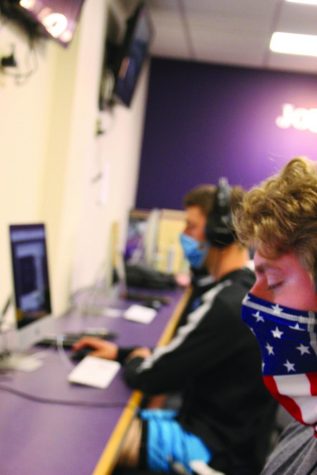
In order to combat the spread of Covid-19, the schools have taken many precautions and made changes to provide a safer environment for learning.
The hallways and sidewalks have one way traffic patterns, masks are required along with six-foot social distancing, plexiglass was installed in classrooms and cafeterias, sanitizing is required after each class period, hand sanitizer mounts have been placed on walls and temperature checks are also required for the students.
Schedules have been changed from a typical seven period day to block scheduling in order to reduce the number of exchanges between classes.
Ashland High School is splitting lunch into two locations so the kids have more space to spread out.
These changes have proven to be a challenge for the staff and students, especially for Angela Spreng, Loudonville High School band director, whose way of instructing took careful planning.
During the initial lock-down in March, Spreng was facing the challenges of Zoom teaching.
“It was especially difficult because I couldn’t have more than one student play at a time on zoom meetings because the speakers couldn’t handle that much audio coming in at once,” she said, “ I ended up using the time more to just check in with kids on how they were doing with their other classes and handling things emotionally.”
Not only was this a challenge then, but even now online learning and social distancing are still generating complications.
“I do not like it,” she said. “As a band teacher, it is very difficult to teach a kid how to play an instrument when you can’t be right there next to them.”

Luckily band class can still be held, but they look different than a typical year.
“My band classes are 100% outside this year,” she said. “I actually really like the block scheduling because even though I don’t see my kids everyday, I see them for 1 hour and 15 minutes every other day and we can get a lot done.”
Overall, despite the adaptations happening within the schools, everyone is glad to be back.
“If there was one positive that came from Covid it’s that the students who didn’t always appreciate coming to school and being in a school building realized not being allowed to be here is kind of worse, so a lot of students are just grateful to be back,” Swearingen said.
Although it is unknown what the future classroom will look like, Spreng believes teaching has been peramntely altered.
“I do think teaching has been forever changed,” she said. “I think a lot more students will choose online options over in-person than before.”
Swearingen speculates if there is a lot of success for the students this year, then this way of teaching will continue, but for now they are all just trying to adjust.
“If we saw that students were experiencing more success, then I think there is a high likelihood that that would continue, but anything I would say is purely speculation,” she said. “But, I think for right now this is the new normal and we are all just trying to cope.”




